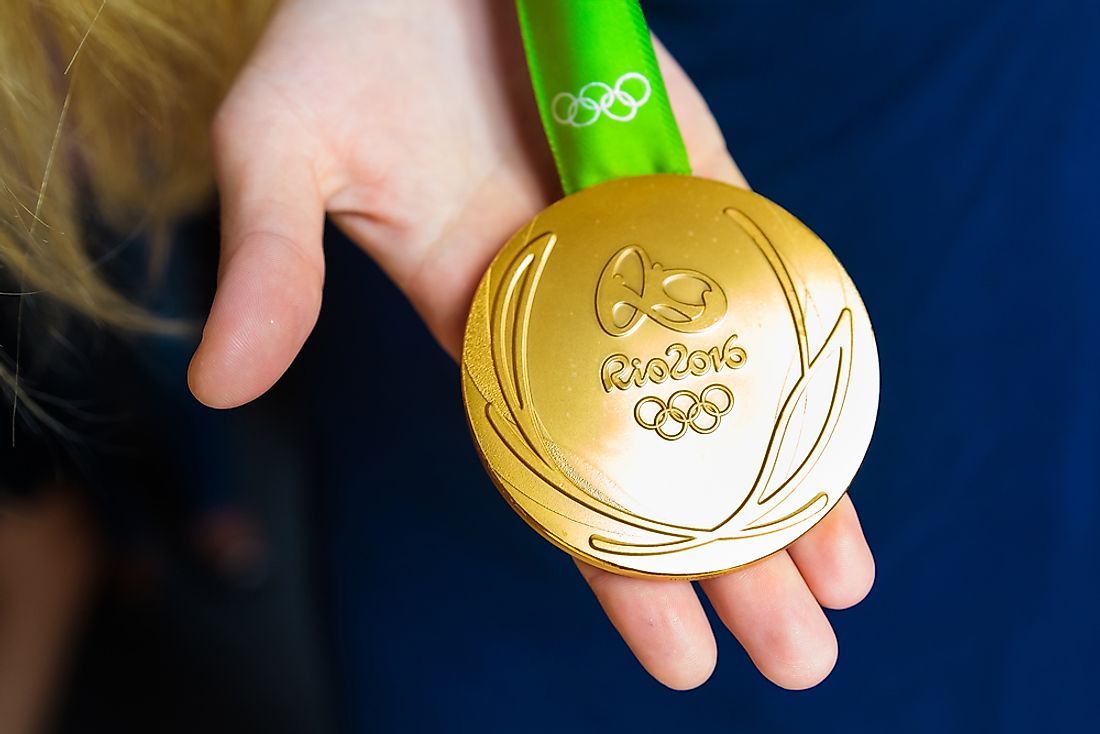What Are Olympic Medals Made Out Of?

Podium finishers receive Olympic medals during the finals of each Olympic event. The winner, first runner-up, and second runner-up get gold, silver, and bronze medals respectively. Olympic Games’ protocol is very clear on who can award the medals and how the athletes should receive the medals. Most people are curious about the medals’ compositions as some believe they consist of the elements that their names suggest. As described below, this belief used to be true but not the same today.
History of Olympic Medals
Since the first modern version of the games in 1896, medals have come in different shapes, masses, and composition. The 1896 games had medals but no gold medal as the winner received a silver medal and an olive branch. Both the first runners-up and the second runners-up received a bronze or copper medal together with a laurel branch. The 1900 Olympics used trophies instead of medals. The awarding of the three medals started during the Summer Olympics of 1904 in St. Louis, Missouri.
Gold Medal
The 1912 Games of the V Olympiad in Stockholm Sweden were the last Olympics to use pure gold for the gold medals. Currently, Olympic gold medals are silver with a solid gold plate on top. Although the National Olympic Committee (NOC) in each host nation gets to decide the composition of the medals, the International Olympics Committee (IOC) has set minimum standards for the gold medals. According to the IOC standards, all gold medals should be sterling silver of at least 0.925 grade (92.5%) covered with pure genuine gold of at least 0.2 ounce. Additionally, gold medals must be at least 2.362 inches in diameter, at least 0.12 inches thick, and have an inscription of the name of the Olympic sport. The hosting NOC mints and designs the medal after which the IOC approves.
Silver Medal
Silver medals usually have a sterling silver grade of .925 (92.5%) grade. In addition to this property, all the other measurements remain the same. Other requirements are that the medals be circular with a diameter of no less than 2.362 inches and a thickness of 0.12 inches or more. Silver medals should also have the sports details engraved on them.
Bronze Medal
For the bronze medal, NOCs carefully makes an alloy of copper and other elements, usually tin and zinc, to form a strong bronze medal that is resistant to erosion. The three metal compositions are 97% copper, 2.5% zinc, and 0.5% tin. The size and dimensions remain similar to that of gold and silver medals. Prior to the 1904 St. Louis Olympic Games, only the first two positions got awarded.
Different Medal Compositions During the Olympics
The IOC medal regulations allow NOCs to use the official Olympism design on the front of each medal and add a local design at the reverse.
Beijing 2008: With the obverse side similar to that of the previous medals, the reverse side was unique as it had the Beijing Olympics logo surrounded by a circle of jade. Bi, an ancient Chinese jade with dragon inscription inspired the design. According to the Chinese NOC, the design symbolized virtue and nobility which are Chinese’ values of honor and ethics. The medals were 2.756 inches in diameter.
London 2012: The medals obverse side had the inscription “XXX Olympiada London 2012” together with Nike, the Greek goddess of victory, flying into the Panathinaikos stadium to give victory to the best athlete. The reverse had the London 2012 Olympics logo. As for the ribbon, the design represented the Thames River. The medals had a diameter of 3.346 inches.
Rio 2016: In 2016, the Rio Summer Olympics NOC used eco-friendly medals for the first time in the history of the games. The gold medal did not have any amount of mercury. Generally, separation of gold and mercury is usually very difficult and therefore previous Olympic gold medals had traces of mercury. 30% of the sterling silver used was a product of recycling and so was part of the copper used in making the bronze medals. The ribbon was also 50% recycled. On the obverse, the medals had Nike, the Greek goddess of victory, flying into the Panathinaikos stadium. Nike’s figure had an inscription, “XXXI Olympiada Rio 2016”. On the reverse, there was the Rio Olympics logo surrounding laurel leaves which symbolizes victory. The total weight of a medal was 17.637 ounces.







